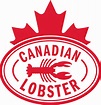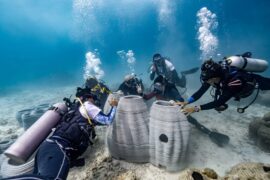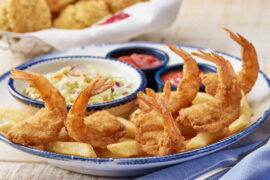While lobster products are always in abundance in Boston, the celebrated marine crustacean’s culinary versatility will be more magnificently displayed than usual in the Hub City from March 19-21. That’s when the annual Seafood Expo North America event takes place at the Boston Convention & Exhibition Center.
At the front of the “pincer movement” on buyers will be suppliers of value-added frozen lobster products from the Canada and the USA, with the charge being led by companies from Nova Scotia and Maine.
 Clearwater Seafoods Limited will hold forth at Booth 2765 with ready-to-cook Nova Scotia Prime Lobster meat. Through a specialized high pressure extraction process, raw lobster meat is released from its shell and then frozen in a variety of formats, giving chefs the versatility to prepare the product in several ways, without the inconvenience of cooking and shelling live lobster.
Clearwater Seafoods Limited will hold forth at Booth 2765 with ready-to-cook Nova Scotia Prime Lobster meat. Through a specialized high pressure extraction process, raw lobster meat is released from its shell and then frozen in a variety of formats, giving chefs the versatility to prepare the product in several ways, without the inconvenience of cooking and shelling live lobster.
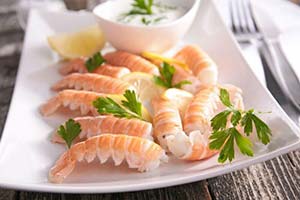 Clearwater will also be promoting Norway Lobster. Prized for its delicate flesh and sweet, succulent taste, the product originates from cold waters surrounding the United Kingdom. Whole Norway Lobsters are slim, with orange-pink shells and bodies growing up to 10 inches in length. The product range is available in a number of formats.
Clearwater will also be promoting Norway Lobster. Prized for its delicate flesh and sweet, succulent taste, the product originates from cold waters surrounding the United Kingdom. Whole Norway Lobsters are slim, with orange-pink shells and bodies growing up to 10 inches in length. The product range is available in a number of formats.
Among products showcased by Cozy Harbor Seafood Inc. of Maine at Booth 2725 will be Twin Lobster Tails distributed to retail stores in 212-gram SKUs containing a pair of raw, flash-frozen split lobster tails. Promoted as “Great on the Grill,” the trap-caught product comes in a vacuum skin pack tray featuring a full-color dual display sleeve.
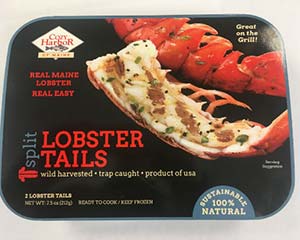 Cozy Harbor will also offer Cooked Tail Claw Knuckle Lobster Meat packed with water in a protected sealed cup. Like all of the company’s lobster products, the 200-gram item is harvested from the wild.
Cozy Harbor will also offer Cooked Tail Claw Knuckle Lobster Meat packed with water in a protected sealed cup. Like all of the company’s lobster products, the 200-gram item is harvested from the wild.
According to NOAA Fisheries Services, Maine landed 85 percent of the lobster caught in the United States in 2013. Lobster is a culinary icon and economic powerhouse in the state, employing thousands of people and contributing more than $1 billion to the economy each year.
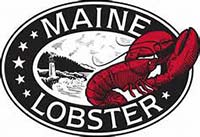 As one of the oldest continuously operated industries in North America, the Maine Lobster sector has a long history of sustainability and traceability practices deeply rooted within a close-knit group of multi-generational family lobstermen. They have self-regulated the industry and practiced the same responsible fishing practices for 150 years. Even today, all Maine Lobsters are hand-caught from small day boats.
As one of the oldest continuously operated industries in North America, the Maine Lobster sector has a long history of sustainability and traceability practices deeply rooted within a close-knit group of multi-generational family lobstermen. They have self-regulated the industry and practiced the same responsible fishing practices for 150 years. Even today, all Maine Lobsters are hand-caught from small day boats.
Hard-Shell vs. New Shell
North and east of the Maine border, suppliers regard the hard-shelled Canadian Atlantic Lobster as the “King of Seafood.” The highly nutritious and delicious source of protein is known by many names including Atlantic Lobster, American Lobster, Canadian Reds and Northern Lobster.
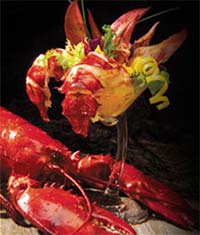 Canadian Atlantic Lobsters are harvested off the rugged North Atlantic coast of the Maritime Provinces. They have been pulled from the icy salt water the same way for generations, in traps attached to lines hauled one at a time. Since the lobster industry in Canada is based on an integrated fisheries management approach, it ensures that harvesting and processing methods are conducted in an ecologically responsible manner.
Canadian Atlantic Lobsters are harvested off the rugged North Atlantic coast of the Maritime Provinces. They have been pulled from the icy salt water the same way for generations, in traps attached to lines hauled one at a time. Since the lobster industry in Canada is based on an integrated fisheries management approach, it ensures that harvesting and processing methods are conducted in an ecologically responsible manner.
The seasons for harvesting lobster in Canada are staggered to protect the vulnerable summer moults. Meat from hard-shell lobster is low in fat and carbohydrates while high in protein. In fact, it has less saturated fat, calories and cholesterol than many lean meat such as pork, extra-lean beef, and white chicken. At less than 100 calories per serving (89 percent of calories from protein), lobster is a wise meal choice for any dietary regimen.
Meanwhile, the folks in Maine are big promoters of “New Shell Lobster.”
From mid-summer to mid-fall, lobsters in Maine waters shed their old shells and grow new ones. These tender crustaceans are called “New Shells,” and they’re prized by well-informed locals as a seasonal delicacy.
Much softer than they were in their cold-weather shells, they break easily when cooked, serving up the most tasty lobster meat of the year. Because the shells are tender, lobster enthusiasts can dig in with bare hands, sans tools or sore fingers.
Visitors to the North American Seafood Expo will be able to sample lobster from Maine, Canada and the rest of the world, where Hard-Shell vs. New Shell sell pitches will be among the many lines heard by purveyors of seafood.

